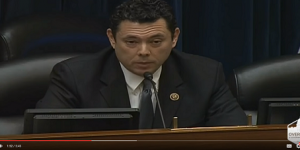By Uriel J. Garcia, The Santa Fe New Mexican
Aug. 24–Ten states and the District of Columbia allow undocumented immigrants to obtain driver’s licenses. But only two of them — New Mexico andWashington state — don’t distinguish between the type of licenses issued to U.S. citizens and people without proof of immigration status.
In most states, immigrant licenses cannot be used as identification for purposes such as boarding an airplane. Other than New Mexico and Washington state, jurisdictions that allow undocumented immigrants to apply for driver’s licenses issue an alternative type of license that restricts how it can be used.
A report last week by the Washington, D.C.-based Pew Charitable Trusts reiterated the statistics on driver’s licenses as part of a new report on immigration and public policies that have been instituted by states.
Unlike New Mexico and Washington, the other states licensing undocumented immigrants use identifiers on driver’s licenses in order to comply with the federal Real ID Act, a controversial national identification system that has been repeatedly delayed by the federal government. The 2005 law authorizes states to provide licenses to immigrants living in the United States illegally only if the licenses are distinct from regular licenses in specific ways, according to the report issued last week by the Pew Charitable Trusts, a nonprofit organization that produces studies for policymakers.
Washington was the first state to allow undocumented immigrants to apply for a driver’s license. New Mexico followed suit in 2003, when then-Gov. Bill Richardson, a Democrat, signed a bill allowing New Mexico residents to apply for a license regardless of immigration status.
In the past few years, states have followed New Mexico and Washington’s practice, but they have enacted more restrictions on how undocumented immigrants can use their driver’s licenses. California, Colorado, Connecticut, Illinois, Maryland, Nevada, Utah, Vermont and Washington, D.C., also license people without proof of immigration status, but with limitations.
For example, since 2013, Illinois’ three-year driver’s licenses for undocumented immigrants state in capital letters on the front of each card that it cannot be accepted as a form of identification for things such as boarding a plane or voting in local elections. In Colorado, which enacted its law in 2014, licenses for undocumented immigrants have a black banner and have “not valid for federal identification, voting, or public benefits” printed on them.
” New Mexico is a special case because New Mexico is one of the two states that issue the same driver’s licenses to everybody regardless of immigration status,” said Michele Waslin, who co-authored the Pew Charitable Trusts report, during a conference call on Tuesday.
New Mexico’s Republican governor, Susana Martinez, has campaigned for five years to repeal the state’s immigrant driver’s license law, which she calls “dangerous.”
But all of Martinez’s attempts to repeal the law have failed, including one this year.
The state House of Representatives approved a repeal bill that Martinez wanted, but a Senate committee rejected it. Instead, state senators voted 35-5 for a different bill that would have continued to allow undocumented immigrants to receive driver’s licenses while at the same time putting the state in compliance with the Real ID Act.
The measure New Mexico senators backed, similar in many respects to those in other states, would have established two tiers of state driver’s licenses.
Eleven of 16 Senate Republicans voted for the compromise bill, a blow to Martinez. The governor has insisted on nothing less than repeal of the licensing law, and until this year, Republican legislators had agreed with her.
But many Senate Republicans broke from Martinez because they had tired of bickering over driver’s licenses. The compromise bill, co-sponsored by Senate Minority Leader Stuart Ingle, R- Portales, received overwhelming support in the Senate.
Most New Mexico senators say immigrants are integral to the state’s oil, dairy and farming businesses. They also say law enforcement benefits from the law because more drivers learn the rules of the road and are listed in police databases.
Even with provisions for the Real ID Act built into the compromise measure approved in the Senate, Martinez still opposed the bill. The measure died later in the Republican-controlled House.
According to the latest statistics made available by the state’s Motor Vehicle Division, in 2014, the state issued 4,577 licenses to immigrants. That’s the lowest number since 2003, when New Mexico approved a law allowing undocumented immigrants to apply for driver’s licenses. But in that same year, 8,412 immigrants in the state renewed their licenses — a 5 percent increase from the year before, the records show. The peak was in 2010, the year before Martinez became governor, with 15,332 immigrants obtaining licenses.
Officials don’t know how many of those licenses were issued to undocumented immigrants because they don’t ask for proof of immigration status when individuals apply. However, officials generally know when immigrants apply because they either don’t present a U.S. birth certificate or use a valid foreign identification card.
As Waslin noted during the conference call, undocumented immigrants in New Mexico are allowed to provide their Individual Taxpayer Identification Number instead of a Social Security number when applying for a driver’s license, as immigrants who entered the United States illegally cannot apply for a Social Security number. But to qualify for a New Mexico license, immigrants must have proof of identity and state residency.
The report says that New Mexico is home to 1 percent of undocumented immigrants in the country. Overall, 37 percent of the estimated 11 million undocumented immigrants in the U.S. live in Washington, D.C., or the 10 states that allow them to apply for driver’s licenses. California has the largest population of undocumented immigrants — 2.5 million people.
The recent study by the Pew Research Center shows that New Mexico is one of 14 states in which the population of undocumented immigrants declined between 2009 and 2012. The 2014 study says New Mexico lost 20,000 “unauthorized” immigrants, falling from 90,000 to 70,000 during that time period.
Contact Uriel Garcia at 986-3062 or ugarcia@sfnewmexican.com. Follow him on Twitter @ujohnnyg.
___
(c)2015 The Santa Fe New Mexican (Santa Fe, N.M.)
Visit The Santa Fe New Mexican (Santa Fe, N.M.) at www.santafenewmexican.com
Distributed by Tribune Content Agency, LLC.





























